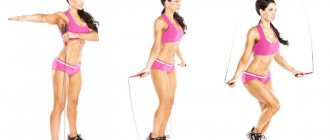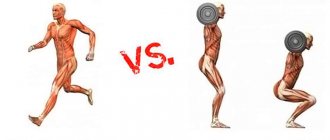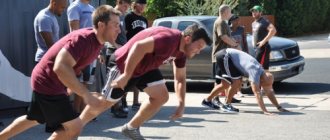Many people have probably encountered this problem. You decide to go in for sports for your health: to maintain body tone, lose weight, and have fun. You choose the most accessible type of physical activity - running.
After reading the advice, you begin your first training session, trying to apply your new knowledge. The result is that the heart breaks out of the chest, shortness of breath torments, the right side hurts, the head is dizzy, the joints crunch and ache. Health does not improve, but only suffers.
At this stage, most people give up running for good. Can running improve your health? - Definitely yes! However, running technique differs depending on the training goal.
If you don’t set sports goals for yourself, but just want to strengthen your body, you need health running.
Differences between health running
Healthy running is an easy type of cardio exercise that is designed to improve health, reveal additional reserves of the body, and stimulate the immune system.
Why you shouldn't run fast
Imagine a person running right now. Surely he rushes forward very quickly, raising his legs high, overtaking pedestrians and cyclists.
If you focus on this image of an athlete, an untrained person will not receive any health benefits from running.
The reasons are as follows:
- Running fast requires a huge amount of oxygen for muscle function. To maintain this level of oxygenation, a person begins to breathe quickly (but shallowly) - shortness of breath occurs;
- An untrained heart has a limited capacity. Therefore, in order to deliver all the oxygen to the muscles, it begins to contract faster. This is how the heart muscle quickly tires;
- The vascular network is also not adapted (there is no developed network of collateral vessels). Therefore, the pressure rises sharply;
- A large volume of blood does not have time to clear itself of metabolic products, being retained by the hepatic vessels. The liver expands, compresses the capsule - pain occurs (right side);
- Due to the above problems, skeletal muscles (+ diaphragm) do not receive enough oxygen to cope with the load - painful spasms occur;
- The PANO indicator is not developed, the muscles quickly become acidic and lose the ability to contract. Sharp fatigue occurs.
Obviously, this is not a healthy run, but a huge stress for the body. What speed should the speed be for running to have a positive effect?
Secrets of “healthy” speed
- Forget about km/h, min/km indicators - they will be individual for each person. Even for one athlete, the pace of health running will change with each subsequent workout;
- Speed is selected based on heart rate. Calculate your maximum heart rate using the formula: MHR = 220 - age. For example , for a 50-year-old person, MHR = 220 - 50 = 170 beats/min. Then count 70% of this figure. For example, 70% at MHR 170 beats/min: 170 * 0.7 = 119 beats/min. This is the pulse you need to work with;
- If even during your slowest run your heart rate jumps above your target, change to a walk. Let your body adapt;
- It is better to measure heart rate using special gadgets: heart rate monitor, smart watch. If they are absent, you can place your fingers on the carotid (neck) or radial (wrist) arteries;
- Maintain a “conversational pace” - see if you can talk while running without feeling short of breath?
The speed will gradually increase. However, running in pulse zone 2 is considered healthy.
Running technique
The technique of healthy running is extremely important. It is the correct execution of each element of the movement that distinguishes the healing effect from the traumatic one.
Download training plans to prepare for the marathon and half marathon.
Start preparing right now!
Video yourself to track + correct the most common mistakes.
The main difference between running and other sports disciplines is the presence of a flight phase + impact load on the joints of the lower extremities.
The most important element of technique is correct landing.
| Error | Correct technique |
| Landing on the heel leads to injury to the knee joint. Often a consequence of taking too wide a step with the foot forward | Landing on the midfoot or rolling your foot from heel to toe |
| “Punching” the foot with the toe—loading the periosteum and ankle. Often combined with high running speed | Landing on the midfoot or rolling the foot from the toe to the middle |
| Landing on the foot in front of the body: the leg is carried forward, lands in front of the center of gravity - knees are injured | Landing the leg under the center of gravity (pelvis) without scooping up the earth |
Other mistakes in running technique
Health-improving running relieves + strengthens not only the joints of the legs, but also the spine. The spinal column also receives shock during landing. Here, in addition to the positioning of the legs, the following are important: the muscles of the back, abs, shoulder girdle, neck, and head position.
| Error | Correct technique |
| Excessive arching of the lower back/slouching while running - improper distribution of the load on the back muscles. The spinal column may become deformed | A straight back is a straight line from the pelvis to the top of the head. The load is uniform |
| Shoulders rise up and tighten. The shoulder girdle is constrained, the load is distributed incorrectly, blood flow is disrupted | Shoulders down and relaxed, slightly pulled back |
| The neck leans forward or as much as it leans back. The blood circulation of the vessels of the neck is disrupted, which means the nutrition of the brain | The neck is straight, the neck muscles are relaxed |
| The head is tilted forward or looking down (at the feet). Often found when running over rough terrain. Blood circulation to the brain is impaired | The gaze is directed forward - 1.5 meters in front of you. The head is straight |
In addition, the healthy running technique includes: step frequency (cadence) greater than 160/min + short step length (up to 70 cm). From the outside, the training does not look so impressive - a person often shuffles his feet, maintaining a low speed. However, the benefits of such training are much higher!
Duration and number of training sessions
The first lesson should last 15-30 minutes. Then the duration of jogging should increase by 10% every week to 1 hour.
The first week, exercise 2-3 times. Then gradually add 1 workout/1-2 weeks. There should be a maximum of 5 workouts. There is no need to exercise every day, the body must fully recover.
Fartlek
Don't forget that running shouldn't be serious hard work - it should be fun! Fartlek is a fun running exercise that you may have done before. It's similar to interval training, but not as intense.
You set yourself a goal, for example, you force yourself to walk until you reach that road sign or maybe that tree ahead. Then you slow down to recover, and then speed up until you reach the red car parked at the end of the street!
Fartlek means "speed game" in Swedish, so play with running and have a lot of fun with it.
Who will benefit
Like any cyclic sport, running has its own indications and contraindications for training. So, who will benefit from health running?
Chronic diseases
- Chronical bronchitis. This is especially true for “smoker’s lungs”. Running has a drainage function - it helps remove phlegm + strengthens local immunity;
- Atherosclerosis, mild anemia, hypotension;
- Diseases of the gastrointestinal tract, especially functional conditions;
- Osteochondrosis;
- Headaches, dizziness.
Before you start running, be sure to consult your doctor. Some diseases are a contraindication to active physical activity.
Contraindications
- Recently suffered a stroke, myocardial infarction, or an attack of cardiac arrhythmia;
- Thrombophlebitis, phlebothrombosis;
- Gallstones + urolithiasis;
- Diabetes mellitus type 1 + type 2 on insulin;
- Acute phase of rheumatic diseases.
Excess weight
Healthy running that burns fat! It is in the 2nd pulse zone that the active destruction of fat deposits occurs - this is the simplest, most affordable, effective way to lose weight.
As you know, a normal BMI is a big plus for the health of the heart, joints, and endocrine organs.
Important to remember:
- Fat begins to be burned after at least 30 minutes of running;
- If you are obese, running should be preceded by walking;
- Be sure to watch your diet - maintain a calorie deficit.
Rehabilitation period
The healthy running technique involves gentle stress on joints, muscles, and ligaments. Therefore, athletes with a history of injury often begin to engage in such running in order to maintain body tone.
Interval
This type of running is a mixture of high-intensity bursts of speed with breaks for jogging and rest.
What's the point of interval running? Short bursts of intense bursts followed by periods of lower intensity recovery will burn a lot of calories in a short amount of time, challenging your strength and endurance. The science backs it up: Interval training improves performance more than moderate-intensity training, according to a study conducted by the Norwegian University of Science and Technology.
Intervals allow you to train at a faster pace than other types of running, thereby improving your physical fitness.
Effect on organs and systems
Let's take a closer look at how healthy running strengthens the body.
The cardiovascular system
- Running is a cyclic type of load. The heart becomes more resilient. Stroke volume increases, heart rate decreases. An athlete can run longer at low heart rate zones, stimulating fat burning + strengthening the body;
- A network of collateral vessels develops. Blood supply to muscles, internal organs, and the heart itself improves;
- The amount of hemoglobin and red blood cells increases - oxygenation of all organs, including the heart + brain, improves;
- Hydromassage of blood vessels while running is a prevention of atherosclerosis + a way to increase the elasticity of the vascular wall;
- Healthy running can be a way to prevent varicose veins.
According to scientific research after 1 year of regular jogging:
- SV of the heart increases from 70 ml to 80 ml;
- MIC increases from 22 to 27 ml/kg. For intense training - up to 35 ml/kg
- Resting heart rate decreases from 78 to 62 beats/min.
Respiratory system
- The drainage ability of the lungs increases - sputum is removed;
- The volume of the lungs increases, the body’s ability to consume oxygen increases;
- The active participation of the diaphragm in abdominal breathing promotes deeper + even breathing;
- The protective properties of the respiratory mucosa are enhanced.
Musculoskeletal system
- Healthy running helps train the muscular system, thereby stabilizing the joints and spinal column;
- Stretching increases due to a cool-down after training;
- Capillarization of muscle fibers increases, the number of mitochondria and their enzymatic activity increases;
- The number of slow muscle fibers responsible for endurance is growing;
- The work of osteoblasts is stimulated - bone mineralization and vertebral stability increase;
- The trophism of the tissues of the musculoskeletal system improves, and recovery occurs faster.
Nervous + endocrine system
- The transmission of neuromuscular impulses improves;
- The number of so-called “hormones” of happiness is growing: endorphin, serotonin, dopamine. Reduces anxiety, improves mood, eliminates depression. There is even a concept of “runner's high” associated with the release of these substances after a run;
- Sugar levels decrease due to the release of pancreatic hormones.
Digestive system
- The health-improving running technique involves vibration of internal organs. In this way, intestinal motility is stimulated and stool improves;
- Training promotes active discharge of bile and improves blood circulation in the hepatic veins. If you have biliary dyskinesia/cholelithiasis, consult your doctor before starting training.
Sprint
Sprinting is a race over short distances that must be run at maximum speed throughout the entire journey. As a rule, it takes from 60 to 400 meters.
Sprint training is important because it helps improve your fitness. In addition, they help develop fast-twitch muscle fibers, build muscle, increase heart rate and increase calorie burning. Along the way, you will develop dexterity, reaction speed, and coordination of movements.
Sprinting is also recognized as the best fat burner. A study published in the British Journal of Sports Medicine found that high-intensity training such as sprinting burned a much greater amount of total body weight and fat than leisurely jogging.
If you constantly train in the gym and are concerned about gaining muscle mass, then you won’t find a better explosive, short “pumping” set. According to research conducted by scientists from Australia, aerobic exercise is necessary for bodybuilders. Spending 15 seconds sprinting will increase your muscle mass. Thanks to sprinting, your metabolism will speed up and changes in muscle structure will occur. The synthesis of enzymes will increase, and as a result, the muscles will become stronger and increase in volume.
Tempo
This running is easier to explain as an exercise performed with effort at a moderate intensity. To make sure that you are doing everything correctly, you should perform a speaking test: if you are able to say two or three words at the same time, then you are running too slowly. If you can't say a word, it means you're running too fast.
The benefit of tempo running is that, when done correctly, it increases endurance—essentially, the body learns to move faster and for longer.








